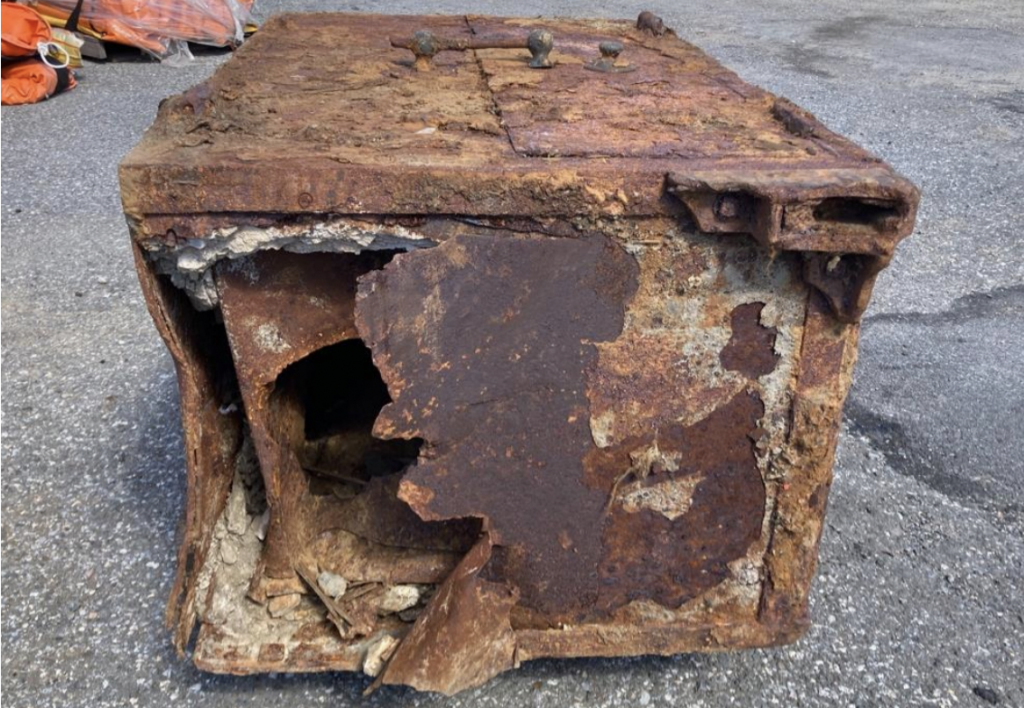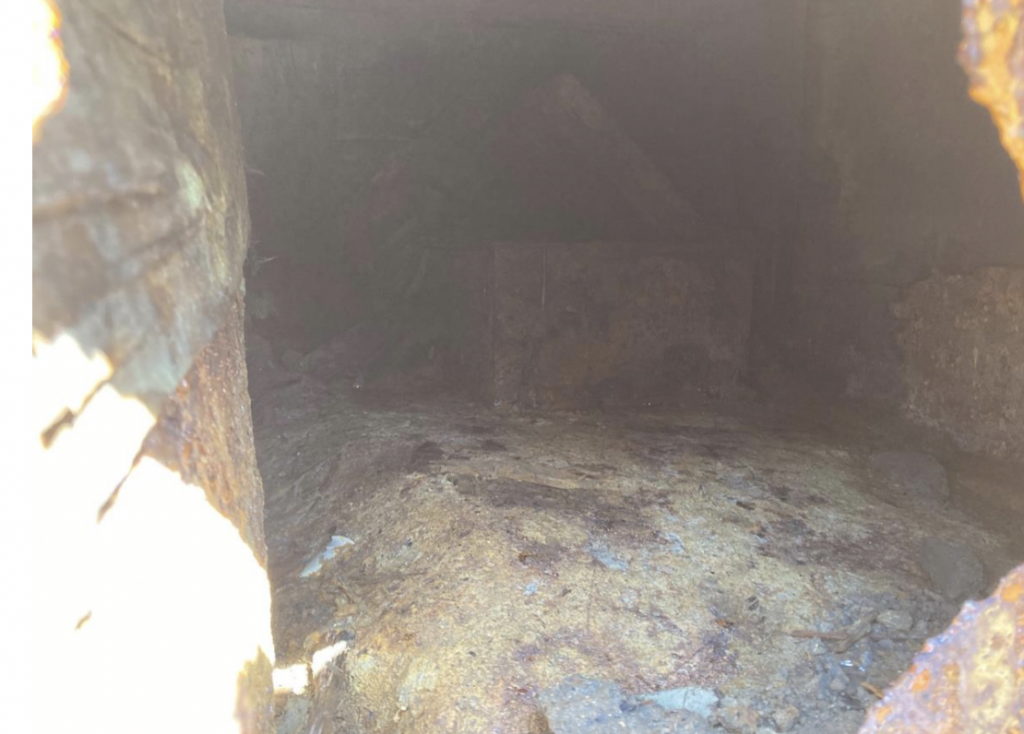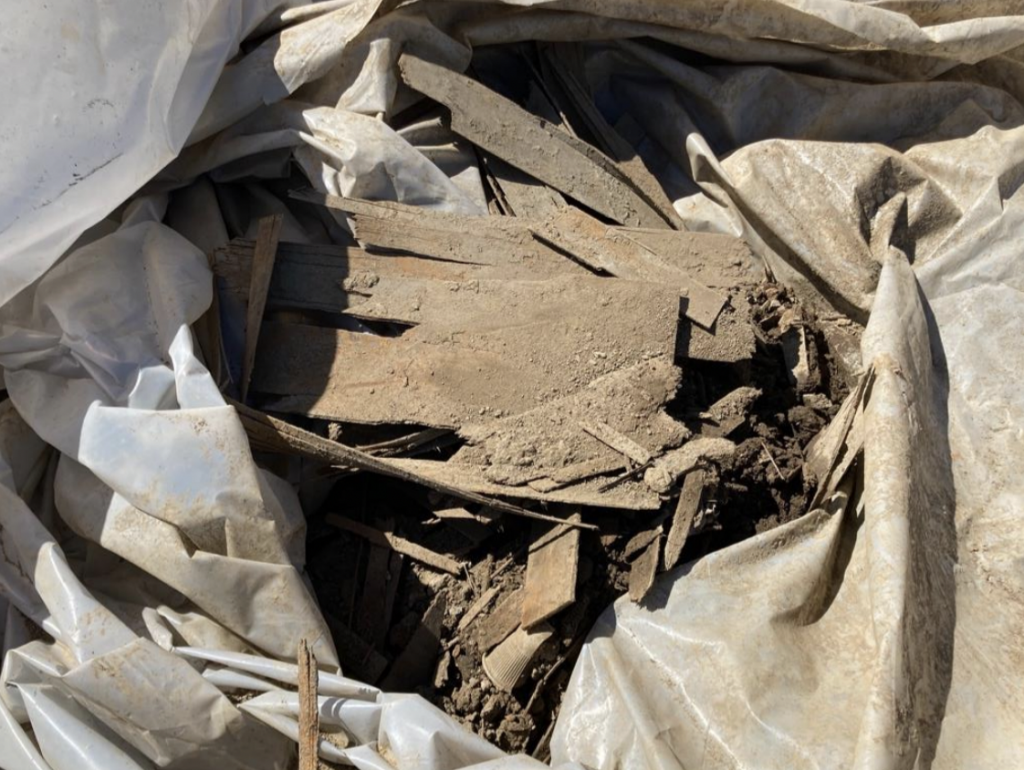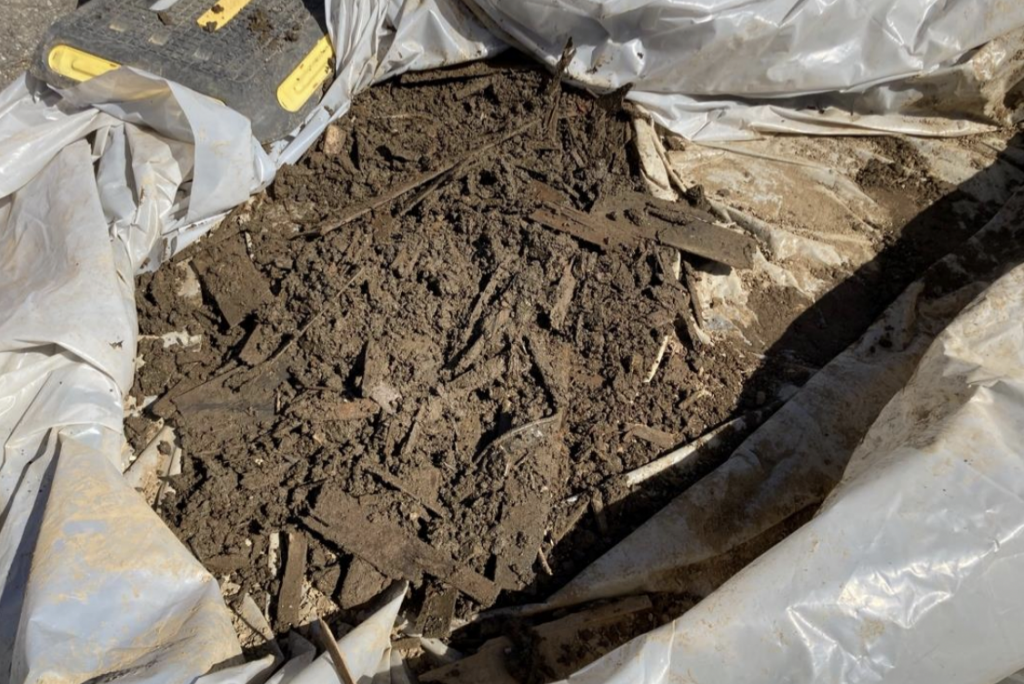This memorandum presents the findings of the Archeologist’s review of screened sediments at the dredge material processing facility in New Jersey from Level 1 Monitoring. The screened sediments are from the dredging for RTA1 conducted from November 2020 to April 2021 at the Gowanus Canal Superfund Site in Brooklyn, New York. The purpose of this memorandum is to present recommendations for the items retained from sediment screening at the processing facility and then reviewed by an archeologist on May 3rd and May 28th of 2021.
INTRODUCTION
The dredge material was processed according to the Level 1 Archeological Monitoring protocol outlined in the draft Cultural Resource Monitoring Plan (revised September 2020). This protocol calls for dredged soft sediments to be screened over 4” bars on a vibrating platform. Items recovered during the screening process are then sorted. Items of potential interest (possible artifacts or objects of local interest), as described in the draft Cultural Resources Monitoring Plan (CRMP) (revised September 2020), were placed in a separate stockpile and photographed daily for archeologists to review and then placed in a holding area to be inspected weekly.
RESULTS
An archeologist conducted scheduled site visits between December 4, 2020 and April 23, 2021 to review the recovered items in person with the assistance of a machine and operator to sort through stockpiled items. Photographs were taken of stockpiled items. Recovered items are designated as artifacts, objects of local interest or debris according to section 4.3 of the CRMP and described below.
Artifacts
Artifacts are defined as meeting all of the following criteria:
- Identifiable by type, function, material and time period;
- Has an identifiable association with a specific building, site, event, or person along the Gowanus Canal during the canal’s period of significance (1853 to 1965); and
- Confirms previously unconfirmed archival information along the canal or reveals new information that changes our understanding of the history/development of the area.
Objects of Local Interest
Objects of Local Interest are defined as meeting all of the following criteria:
- Identifiable by type, function, material and/or time period;
- Has a general association with the area, but not with a specific site, event, or person along the Gowanus Canal during the canal’s period of significance (1853 to 1965); and
- Does not confirm previously unconfirmed archival information along the canal or reveal new facts that change our understanding of the history of the area.
Debris
Debris is defined as any other item recovered from excavation/dredging, including unidentifiable objects, objects with no apparent association with the local area, construction debris, objects made after 1965 and natural items (such as trees, brush, rocks, etc.).
A total of 18 items of potential interest were retained for cleaning, research and assessment. Of these items, ten are items of local interest. The remaining eight items are either relatively recent in manufacture (outside the period of significance for the canal) or cannot be accurately dated and provide no historical information and therefore designated as debris. These items are recommended to be discarded.
The items recommended for retention consist of objects of local interest. Many of the items could not be directly associated with a particular property or business per se but were determined to be of the proper age, can be put into an historical context, and associated with the Gowanus Canal environment and activities. They are also heavier items that would have most likely remained where they were deposited vs. something that could drift to another location and therefore, most likely associated with the property they were found close to.
As per section 4.10.4 of the CRMP, objects of local interest may include small, non-porous objects of local interest that can potentially be turned over to interested parties for display or for their collection, subject to cleaning/decontamination procedures to be established, a USEPA determination regarding the appropriateness of such an action; an agreement among all interested parties (including, at a minimum, the Gowanus Remediation Team and the interested party) will likely be required.
Items Recommended for Retention
Item of Local Interest 1 – Mounted copper fire extinguisher.
This item appears to be a copper fire extinguisher (Photograph 1). The eye-holes at the base of the item suggest that it would have been bolted to a fire truck, or perhaps a fire boat. Although the item has no manufacturing date or information on it, a 1923 advertisement for a Stutz fire truck (Figure 1) illustrates three types of mounted extinguishers on the side and rear of the truck is an example of this type of apparatus. Fire departments in the area would have used this type of extinguisher.
Measurements: Height 19” Width 6”


Item of Local Interest 2 – Brass Component of a Fire Suppressant Apparatus
This brass item was manufactured by the Larkin Manufacturing Company of Dayton, Ohio (Photograph 2). The Larkin Mfg. Co., originally the M.D. Larkin Supply Company, specialized in fire suppression equipment and was incorporated in 1907.1 A 1915 article from in Fire and Water Engineering Magazine lists the types of equipment the company manufactured and distributed 2. Fire departments in the area would have used this type of equipment as safety technology improved.
Measurements: Length 10” Height 9” Width 3”

1) History of the City of Dayton and Montgomery County, Ohio, Volume 2
2) Fire and Water Engineering, Volume 58

Item of Local Interest 3 – Iron Mooring Cleat.
This iron mooring cleat (Photograph 3) is hardware typically used to secure a rope tied to a boat while docked, or vise-versa. These types of cleats would have been used throughout the canal to tie off barges and other watercraft. Although no date can be assigned, it represents activities related to the canal’s past.
Measurements: Length 36” Height 6” Width 4”

Item of Local Interest 4 – Iron Mooring Bollard with Long Bolts.
This undated mooring bollard was used to secure watercraft to a dock or pier. The large size and integrated triangular foundation suggest that it was used at the point of a tapered pier and its use was related to larger boats and barges (Photograph 4). The long iron bolts were used to secure it to the bulkhead (Photograph 5). The welded construction dates this bollard to the 20th century. These bollards can be associated with the later part of the canal’s commercial, industrial and transportation activities.
Measurements: Length 58” Height 19” Width 42” (Bollard 13” in diameter)


Item of Local Interest 5 – Wood and Metal Cart Wheels and Axle
This item appears to be a set of metal wheels from a narrow industrial cart (Photograph 6). Although undated, this item represents the industrial, shipping and storing character of the area and is most likely associated with the Gowanus Canal’s commercial, industrial and transportation activities.
Measurements: Length 21” Height 14”

Item of Local Interest 6 – Incomplete wood and iron wagon wheel.
This undated item was typical of the 19th and early 20th centuries. The wheel has an iron hub and tread with wooden spokes and rim. It was constructed in two-spoke sections with an attached rim section. Several sections are missing (Photograph 7). This item represents the industrial, shipping and storing character of the area and is most likely associated with the Gowanus Canal’s commercial, industrial and transportation activities. The wood portion is porous and is most likely difficult or impossible to decontaminate and should therefore be discarded. However, the metal portions of the wheel, the hub and metal tread, could be decontaminated and be retained as an object of local interest
Measurements: Diameter 56” Depth, Hub 18” Depth, Rim 3.25”

Item of Local Interest 7 – Hand Truck
This item is a typical industrial hand truck (Photograph 8). The wheel is embossed with the name Steelite® (Photograph 9). The ® symbol was not used before 1948 suggesting that the hand truck was used during the mid-20th century at the earliest. This item represents the industrial, shipping and storing character of the area and is most likely associated with the later part of Gowanus Canal’s commercial, industrial and transportation activities.
Measurements: Height 38” Width 21” Depth 27”


Item of Local Interest 8 – Carved Stone Masonry Block
This large carved stone block with egg-shaped design on one side remains undated. Its size suggests it was part of a significant structure (Photographs 10 and 11). Its rough surface on the top, lower sides and back suggest it was inset into a wall. Research was unable to verify if the item is directly associated with the canal as an artifact or an item of interest.
This is most likely a “guard stone”, an exterior architectural element (Photograph 12) located at the corner or gates, entries, and walls to prevent damage from vehicle wheels. Historically, the wheels, and particularly the hubs, of horse-drawn vehicles protrude beyond the vehicle’s body, and were prone to striking the corner of a building or gate. These stones, when struck by a wheel, would push the vehicle away from the wall and allow the hub to pass without causing damage to the building or gate.
Measurements: Height 21” Width 15” Depth 17”



Item of Local Interest 9 – Metal Machine Component
This item contained no manufacturing information.
This is a V style, two-cylinder air compressor (Photograph 13 or, less likely, an engine. It is a design that has been common through the second half of the twentieth century to the present time (Figures 3 & 4). This equipment generates compressed air for tools and machinery frequently used for dockside work and services.
Measurements: Length 28” Height 24” Depth 12”



On 9/21/21 an archeologist went to the staging area to review the interior and contents of a previously recovered floor safe. The interior of the safe was inspected and two piles of removed material were searched by hand. The safe had been cleaned out through a hole in the bottom (Photograph 16) and showed no sign of residual material inside (Photograph 17). The contents of pile one (Photograph 18) consisted of brown soil with fragmented thin wood laminate, likely the interior of the safe and some small fragments of plastic. The pieces could also be parts of former shelves. The contents of pile two (Photograph 19) consisted mostly of the same soil and types of plastic with fewer wood fragments. No items of historic/archeological significance were observed in either pile, or the safe’s interior.




Items Not Recommended for Retention.
Item for Discard 1 – Iron Stove.
This iron stove is undated and contains no manufacturer’s information. It is however, typical of the late 19th and early 20th centuries Franklin stove type. Tied to the stove was a modern rope, suggesting that the stove was used as an anchor and that its addition to the canal was fairly recent (Photograph 20). This type of item could be associated with a business or home in the area but it is impossible to associate it with one based on the stove itself. Furthermore, this stove was used as an anchor as suggested, it was being used for a different function than intended, the modern rope indicates that it was a more recent addition to the canal and the stove could have come from anywhere.
Measurements: Length 26” Depth 15” Height 21” Fire aperture 14”x11” Draft pipe opening 6”

Item for Discard 2 – Miscellaneous Timber 1
A fragment of a notched timber (Photographs 21) was retained as examples of the type of wooden material observed. The presence of two 10-inch metal spikes suggests that it was part of the canal bulkhead or pier (Photograph 22). The timber fragment is possibly associated with the canal bulkhead or dock but could also have floated to the canal from a different location such as Manhattan or Queens. Regardless, wood is a porous material and the timber is most likely contaminated from its time in the Gowanus Canal.
Measurements: Length 75” Width 15” Depth 13”


Item for Discard 3 – Miscellaneous Notched Timber 2
A fragment of a notched timber (Photograph 23). This item was retained as examples of the type of wooden material observed. The timber fragment is possibly associated with the canal bulkhead or dock but could also be part of a building or structure or even a wagon or cart. It is also possible that the timber floated to the canal from a different location such as Manhattan or Queens. Regardless, wood is a porous material and therefore the timber is most likely contaminated from its time in the Gowanus Canal.
Measurements: Length 72” Depth 10” Width 13”

Item for Discard 4 – Iron Gate and Post
These items consist of a fragmented multi-component iron security gate and post. The items contain no manufacturing information to use for dating purposes (Photograph 24). This style of gate and post is still in production and the modern bolts and hinges suggest that it is modern (Photograph 25).
Measurements: Post – Height 141” Width 84” Depth 12”


Item for Discard 5 – Iron Fence
This undated iron fence section was likely set in the top of a masonry wall (Photograph 26). This style of fence has been used well into the 20th century.
Measurements: Length approximately 5’. Bent in half. Height 20”

Item for Discard 6 – Miscellaneous Cylindrical Metal Object
This item has no manufacturing information. It is constructed in multiple components made of iron, lead and copper (Photographs 27 -29 and Figures 5 & 6). This appears to be a 5” artillery shell without its fuse attached.2 The tapered base meets the body of the shell where a pair of “rotating bands”, or “driving bands” are located. Dimensions for a typical WWII-era 5” /38 caliber shell were 127mm wide by 680mm long (5” x approximately 24.4”). It is not clear if this is a WWII-era shell or an earlier shell (example, the 5” /51-caliber gun was common from around 1907 through the 1920s, or the 5”/25-caliber gun common from the 1920s through WWII, and the 5”/38-caliber gun was in service from 1934 to 2008). This is possibly a shell of German manufacture. The presence of dual driving bands may provide the basis for a more definitive identification, but would need to be further by a historic munitions expert to determine any additional information. This research is not recommended as munitions was not an activity associated with the Gowanus Canal. This item may also have been a training round or something brought back from Europe as a memento. The processing facility had the shell reviewed and it was determined to not have any explosives in the round. Even though the shell has been determined as safe, it is recommended to appropriately discard the item as there is no indication that munitions transport or storage was an activity conducted along the Gowanus Canal. Munitions storage was more likely conducted on Governors Island, at one of the many navy or army bases in Brooklyn or other appropriate areas in the vicinity.
2) AN INTRODUCTION TO COLLECTING ARTILLERY SHELLS AND SHELL CASINGS
Measurements: Length 23” Width 5”





Item for Discard 7 – Miscellaneous Carved Stone Block
This gray stone block was recovered after the review process was completed and set aside by processing facility personnel (Photograph 30). It was recorded during the final object review. The lozenge shaped block appears to be a broken-off portion of a larger stone. It contains a square carved out area on its face (Photograph 31) and round hole in the center (Photograph 32). This item may have been used in construction, as a base for items or materials or one of many other functions.
Measurements: Height 28” Width 30” Depth 16”



Item for Discard 8 – Wooden Ball
Six-inch diameter solid wooden ball (Photograph 33). No markings, impressions or other information. The ball could be a toy or sports item (bocce ball) or it could have been used in manufacturing, however, without any markings, it is impossible to tell its exact function. Furthermore, it is made of wood, a porous material, and is possibly contaminated.

CONCLUSIONS AND RECOMMENDATIONS
Considering that the canal was dredged in the 1970s, it is likely that the items observed, regardless of their age, are fairly recent additions to the canal deposit. With no other context besides being in the canal, the historical information gleaned from such items is minimal. However, some of the items certainly do represent aspects of the canal’s past and are items of interest to area residents or canal enthusiasts.
The archeologist concludes that 10 of the 18 items observed during the sediment screening at the processing facility are items of local interest that are generally associated with the commercial, industrial and transportation activities of the canal. The retention of the items of interest is at the discretion of the EPA and the willingness of any interested parties as stated in the Results section above. Per the draft Cultural Resource Monitoring Plan, the archeologist recommends that the eight items recommended to be discarded (as either non-historically/archeologically significant debris or contaminated) at the processing facility that were reviewed by the archeologist as of 5/28/2021 be disposed of.
